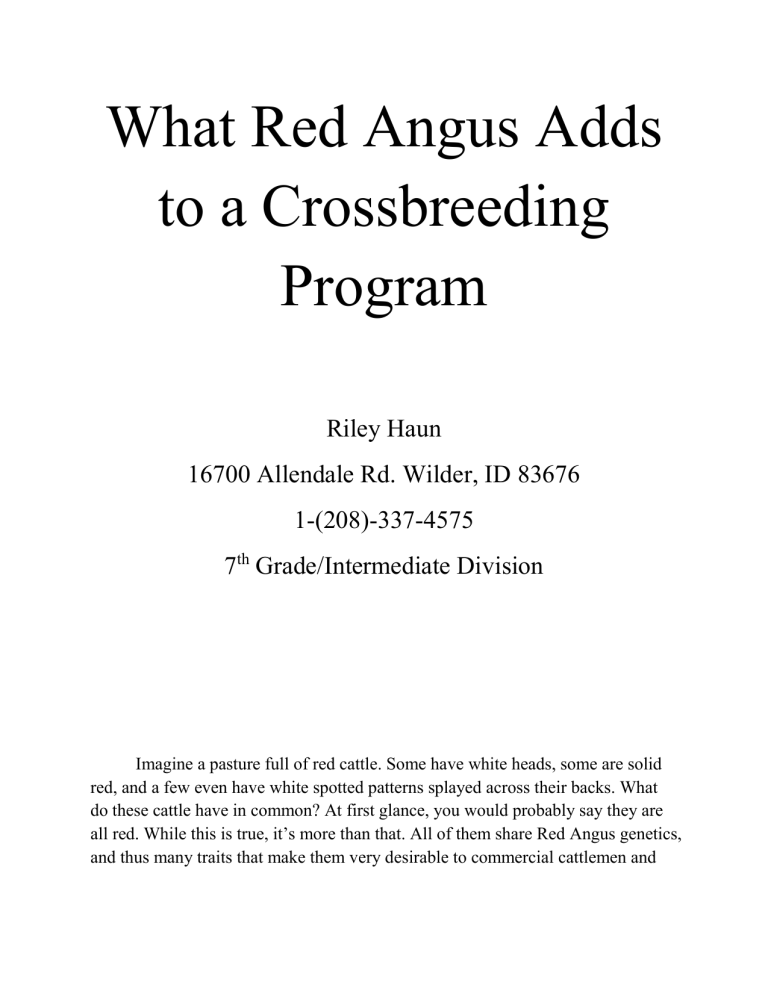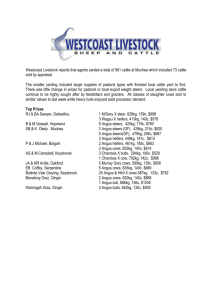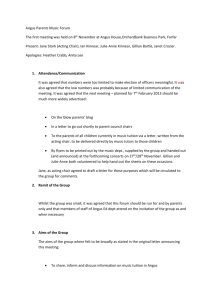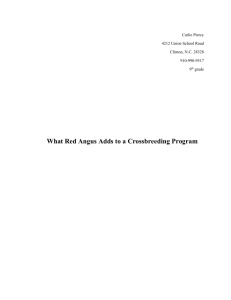What Red Angus Adds to a Crossbreeding Program Riley Haun

What Red Angus Adds to a Crossbreeding
Program
Riley Haun
16700 Allendale Rd. Wilder, ID 83676
1-(208)-337-4575
7
th
Grade/Intermediate Division
Imagine a pasture full of red cattle. Some have white heads, some are solid red, and a few even have white spotted patterns splayed across their backs. What do these cattle have in common? At first glance, you would probably say they are all red. While this is true, it’s more than that. All of them share Red Angus genetics, and thus many traits that make them very desirable to commercial cattlemen and
purebred breeders alike. In my essay, I will be outlining a few of these traits and why they make Red Angus so advantageous to cattle breeders everywhere.
A major reason why Red Angus is so useful is their environmental adaptability. While this is a good trait in any crossbreeding program, it is especially helpful in hot, dry climates, where their heat-resistant red color really comes into play. Red Angus cattle also have an inherent ability to forage for feed and water, which is very good to have especially in areas where the landscape is very arid and feed can be harder to find. The Red Angus Society of Australia is quoted as saying Red Angus and Red Angus crosses are much less prone to eye cancer, and when Red Angus are crossed with Bos indicus cattle they are very highly tick resistant. These are all traits that are very helpful to cattle producers in any area.
Red Angus cattle are also noted for their fertility, calving ease and high maternal qualities. They generally reach sexual maturity earlier than other breeds of cattle, which makes for more calves produced over a cow’s lifetime. Bulls overall have a larger scrotal size than bulls of other breeds, and as a result produce more semen. Red Angus calves have very small birth weights, which is very desirable especially in first-calf heifers, but also provides a huge advantage in older cows as well. Cows often have very high maternal qualities, such as high fertility, mothering ability, and milk production. This provides an advantage for the producer by reducing the amount of motherless bottle calves and time spent trying to help the cow and calf, and therefore money.
A huge advantage of using Red Angus genetics in your crossbreeding program is the efficiency that these cattle are famous for. In fact, Red Angus was the first breed to develop an Energy Maintenance EPD to measure the efficiency of their cattle. A lot of efficiency makes for a lot more pounds gained per pounds of feed. This high efficiency adds a huge advantage to any breeding program, and makes cattle especially ideal for a feedlot setting.
In summary, Red Angus has the perfect combination of traits to add to any crossbreeding program. Just a few of these very desirable traits are their adaptability, fertility, calving ease, maternal qualities, and high efficiency. In my
opinion, Red Angus is the most “bang for your buck” in a crossbreeding program, and provides a massive advantage for breeders on any scale.
Sources:
Red Angus Society of Australia website (redangus.org.au)
Red Angus Association of America website (redangus.org)
“The Common Denominator” pamphlet by the RAAA




